




























Welcome to the fall issue of Edible San Diego, for which we chose the theme of comfort food. Why? Not only do our five senses and favorite memories kick in, but we can dig into a hearty conversation about what food means to us individually and collectively.
What does comfort food mean to you? My absolute favorite foods are grown locally and eaten as simply as possible. At the top of my list is a crisp Fuyu persimmon right off the tree; you have to wait all year for them to ripen, but they are so worth the wait! Share a post on social media about your comfort food, hashtag it #EdibleSDlocalcomforts, and we might share it.
San Diego County enjoys a unique foodscape, including deserts, mountains, farmland, estuaries, beaches, ocean waters, and a year-round climate for agriculture. It’s also a global crossroads, perched on the Pacific Rim and the border with Mexico. Such diversity means people from all walks of life pursue their definition of what’s delicious here. Let’s check our privilege and open our minds to a very broad interpretation of comfort foods for the months of September and October as we explore them in new stories, recipes, and videos. Also, please subscribe to my new podcast Living Local with Edible San Diego, produced by the Specialty Produce Network.
On the subject of comfort foods, please check out the evergrowing list of food-related nonprofits Edible San Diego maintains online because these professionals, volunteers, and donors are out there every day spreading well-being across our local food system.





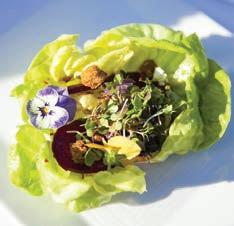
Thank you for your readership and happy fall! The Edible San Diego team, including our fantastic contributors and advertisers, are all united around the mission to share these seasonal stories— because where we focus our attention makes all the difference in the world.
Stokes Publisher, Edible San Diego



Here are three ways to support the local community with your daily cuppa coffee this fall.

San Diegans are smiling brighter thanks to purchases of fair-trade Cura Coffee from Nicaragua, sold at this Point Loma cafe. Proceeds from coffee sales are donated to nonprofit dental clinic Cura Smiles in City Heights, which provides free dental care for those in need.
» jenningshousecafe.com
Located inside this Barrio Logan cafe, the nonprofit San Diego Coffee Training Institute was created to empower those impacted by longterm poverty within their surrounding community. Aspiring baristas and coffee roasters can receive instruction at this certified training lab that has scholarships available for those wishing to advance their professional coffee career.
» cafevirtuoso.com
Offering a menu reflective of its diverse neighborhood, this nonprofit provides job training, leadership development, and mentorship to inspire at-risk youth. The coffeehouse hires baristas without previous experience, including refugees and those transitioning out of homelessness or juvenile detention, and gives them classes during the first 15 weeks of employment.
» cityheightscoffeehouse.org
The no-frills San Diego Chicken Pie Shop in North Park is famous for its chicken pie dinner. The pie mixes shredded turkey and chicken under a basic crust, with chicken gravy ladled over whipped potatoes and the pie alike.
» chickenpieshops.com
A hip vibe prevails at Pop Pie Co. in University Heights, where the steak and ale pie seduces with tangy beef and mushrooms under a flaky pastry. The chicken pot pie, with pearl
onions, is robust, while the Aussie meat pie features a silky mince. Seasonal sweet hand pies like guava cream cheese or lemon curd and mixed berries are not to miss.

» poppieco.com
You’ll find Betty’s Pie Whole tucked inside Elizabethan Desserts in Encinitas. The signature chicken pot pie crowns a delectable mix of chicken and vegetables with a pastry made of flour, butter, and love. Follow it up with a pecan or the butter crust apple pie for dessert.
» bettysspiewhole.com
HILLA few local eateries will warm you up from the inside when cooler weather sparks a craving for pie.OLIVIA HAYO, HALEY Left: A mug of Cura Coffee at Jennings House Cafe. Above: An array of savory pot pies from Pop Pie Co.
Think small front yard libraries with the “take a book, leave a book” model, but brimming with dazzling organic produce. These tiny gardens are small boxes with big goals: to reconnect friends and neighbors through the art of growing real food. When citizens gather together, grow, and share harvests, neigh borhoods become communities.
Urban Plantations, a local edible landscaping company, is partnering with Edible San Diego to build and install Little Free Gardens throughout the county—and you can do it too! Visit the Little Free Gardens website for inspiration, blueprints, signage, and more.

Join us in growing food for our community by creating your own mini-garden at home. Create a shared space with your neighbors to cultivate organic ingredients, right in your own front yard.
Register and get a garden kit at littlefreegarden.com.
Tasty international eats, fresh produce from 53 neighboring farms, and plenty of free parking will lead to a fun weekend outing in Vista. Head to the county’s longestrunning farmers’ market on Saturday mornings to see what the community is cooking.

Look for Genovese basil, living butter lettuce, tatsoi (Japanese spinach), and other nutritious Asian greens at the Sundial Farm stand, specializing in sustainably grown hydroponic vegetables. The produce is grown indoors
without soil and harvested with the roots still attached to preserve flavor and freshness.
» sundialfarmca.com
There’s something magical about shopping for fruit and veggies while holding a paper cone stuffed with fries. Belgium Delights specializes in Belgian-style frites: thick-cut, golden brown, lightly salted spuds with a crispy exterior that yields to soft potato fluff. Say yes to a side of housemade aioli—the garlicky dip is the perfect accompaniment.
» belgiumdelights.com
Joe Servais’s hand-thrown fermentation crocks are attractive enough to put on permanent display in your kitchen. The functional design locks air in and moisture out, plus they’re dishwasher and microwave safe. Shop the large selection from Falcon Hill Pottery at the market, or order something custommade to match your home decor.
» falconhillpottery.com
















The 36-hour boule may be too daunting for beginners. Here, sourdough expert Min Kim shares a guide to making your own starter and three indulgent recipes with less fuss.

The rise of sophisticated sourdough has captured our attention, appetites, and Instagram feeds with mesmerizing scores, perfectly shaped boules, and, of course, the coveted crumb shot. Deep in the rabbit hole of #sourdoughlife, I was hypnotized into a blissful state of homesteading as I dreamt of brushing my flour-dusted hands off a French-striped apron while auditing my quietly rising loaves. I could smell it. I could taste it. And I could feel the chubby fingers of a 2-year-old pinching my toes as a reminder that I don’t have the time nor the patience for two days of stretching, folding, and waiting for a fermented loaf.
Min Kim is responsible for my sourdough obsession as well as the resurgence of my comfort food cravings. After a few days of Insta-stalking and a DM later, I found myself exploring the art of sourdough with the master herself. In that process, I learned one very important lesson to share with sourdough seekers short on time: All you need is a little flour, water, and the wild yeasts in the air. These basic ingredients create a bubbly mixture capable of producing simple recipes that yield far beyond the (albeit wonderfully delicious) loaf, like crepes, tarts, tortillas, and even
sourdough goldfish crackers to feed those chubby 2-year-old fingers. The mother (or starter) is the bubbly mixture I am referring to, and thanks to Kim, it’s the beginner’s gateway to the flavorful world of sourdough.
Although sourdough-based recipes are often made from the same flour as other breads and pastries, the slow fermentation process using the starter ignites a powerful combination of wild yeast, bacteria, and enzymes to transform indigestible grains into nutritious, mineral-absorbing foods friendly on the gut and pleasing to the palate.
Wrangler of wild yeasts and friendly bacteria, Kim is a certified traditional foods cook with a passion for nurturing the body with naturally fermented foods. She teaches private and group classes on how to prepare bone broths, true fermented sourdough breads, properly soaked grains and legumes, lactosefermented vegetables, and cultured dairy.
Follow Kim’s sourdough journey on Instagram @minskitchen or visit biodynamicwellness.com for more info on her sourdough classes.

For best results, begin a sourdough starter culture using organic whole grain flours, especially rye, which is very high in nutrients and fermentable sugars. It’s difficult to begin a starter with all-purpose flour alone. Mixing by hand adds bacteria and yeast to your culture, but it’s not necessary for success. However, working in an environment that is too sterile or one that has been cleaned with heavy cleaning products and antibacterial agents will work against you. Your starter should be ready to use for making bread in a week, but it will be more reliable and have a better flavor profile in 2 to 3 weeks. There will be more homofermentative bacteria (lactic acid with an abundance of yeast) during the first week, and in a few weeks, more heterofermentative bacteria (lactic acid and acetic acid for a better balance of yeast and bacteria) will have taken hold, giving your bread more complex flavors. Once established, continue to feed it with your flour of choice and adjust the hydration to your liking.
Measuring by weight is far more accurate than measuring by volume (i.e. cups or spoons). It’s not completely necessary to use a scale to make a sourdough starter or bread, but the process is more successful with a scale.
Avoid using tap water. Chlorine and chloramines commonly present in tap water work against natural bacteria and yeast.
Whole grain organic rye flour
Spring water/filtered water
Whole grain organic wheat flour Organic all-purpose flour
TOOLS
Digital scale that measures in grams with tare (zero out) function 1-quart Mason jar
Day 1 Mix 100g of whole grain rye flour and 160g of water in your vessel and stir with a wooden spoon or chopsticks.
Scrape the sides clean with a rubber spatula and cover loosely with a lid. Allow it to sit for 24 hours in an area where the room temperature will remain consistently between 72º–80º.
Keep away from other cultures, compost bins, and moldy fruit by at least 6 feet to avoid contamination.
Day 2 Stir mixture and discard half of it. Add 100g of whole grain rye flour and 160g of water and mix well. Scrape the sides clean, cover with lid, and let it sit for 24 hours. Mixture should double in size and fall.
Days 3–6 Increase feedings to twice a day. Each time, stir mixture and discard half of the starter and add 50g of whole grain rye flour and 80g of water and cover. Mixture should smell sweet and yeasty, not foul or off-putting.
Continue to scrape the inside of the container clean with a rubber spatula and mark the level of freshly mixed starter on the outside of your container with tape or a rubber band so you can track the activity. It should rise and fall with each feeding.
Day 7 At this point you should be able to feed your starter with a larger amount of flour.
In a new container, measure out 50g of starter. Add 100g of organic flour (50g wheat and 50g rye) and 100g of water. I the culture doubles and falls, it’ll be ready to use for bread, but I recommend continuing to feed for 2 more weeks. Continue feeding with the 100g mixture once a day. Switch to 50g flour and 50g water once it is healthy and established. Organic all-purpose flour is fine for maintaining the starter after a few weeks of regular feedings have passed, or make a mixture of 50% all-purpose flour and 50% whole grain flour for feedings.
Remember to discard extra starter; there really is no need to keep more than 1 to 2 cups total. The larger in volume your mother starter is, the more you have to feed it to keep it healthy.
Maintain your starter either at room temperature for baking regularly or store it in the refrigerator with weekly room temperature feedings if you don’t bake very often.
If keeping the starter at room temperature, feed it at least once a day, though twice is best, especially in warmer months. Liquid accumulating on the top or an overly acidic smell are signs that suggest the starter is
not getting enough food. If this happens, pour off the liquid before feeding the starter again. You can also discard all but a tablespoon of starter and transfer it to a clean jar before feeding it to freshen it up.
With a digital scale, zero out the weight of your crock. Add 50g of organic all-purpose flour and 50g of spring or filtered water. Mix well and scrape sides clean with a spatula and cover with a cotton dishcloth to absorb any condensation. Scraping the sides clean will prevent thick clumps of starter forming on the inside of your container. Cover with lid.
The starter will grow if kept at room temperature. Don’t let it accumulate to more than about 2 cups in volume. The larger the starter, the more “mouths” to feed, and the culture can weaken because 50g flour and 50g water will not be enough food. Discard the extra starter or make pancakes, waffles, crackers, and more with the excess.
If feeding twice a day in the summer months is undesirable, you can remove the bulk of your starter and feed a smaller amount (10g starter) with 50g flour and 50g water once a day. If you don’t want to throw excess starter away, save the discarded starter in a larger container in the refrigerator to make your sourdough discard recipes.
MAINTAINING IN THE REFRIGERATOR Starter kept in the refrigerator will need to be fed once a week.
Take your starter out of the refrigerator. Remove ¼ cup of starter and set it aside. Discard the remaining starter and rinse out your container with hot water. Place clean container on scale and zero out the weight. Add reserved ¼ cup of starter, noting the weight in grams and adding equal weight in grams of spring/filtered water and organic all-purpose flour. Mix and allow to double in volume at room-temperature (roughly 4 to 6 hours) before returning to the refrigerator to store.
To bake bread, three room-temperature feedings are recommended prior to the bread-making process in order to wake up the starter. For example, if you wanted to bake on Saturday, take the starter out of the refrigerator Thursday morning and continue to follow the feeding instructions but leave it at room temperature. Feed it again with 50g flour and 50g spring or filtered water on Thursday evening and Friday morning, and make your levain Friday evening for starting your dough Saturday morning.
The recipes that follow and many others online can help keep your starter occupied. Store starter dough for a week before it gets too sour, but don’t store more than 2 cups at a time.

Don’t feel guilty if you don’t have time to use all your excess starter and you’d like to throw it away. Septic tanks are happy to have the extra beneficial bacteria.
SERVES 6–8
The use of a mandolin helps achieve nice butternut squash ribbons, but a thick peeler will also work fine here.
CRUST
1 cup all-purpose flour
½ cup spelt flour
½ cup yellow cornmeal
½ teaspoon sea salt
8 tablespoons butter, cut into ½” pieces and kept chilled ¼ cup sourdough starter
2–4 tablespoons ice water
1 cup ricotta cheese
3 tablespoons crumbled feta cheese
½ teaspoon sea salt, divided
1 medium to large butternut squash
3 tablespoons shelled pistachios
6 thin slices prosciutto, sliced into 1” strips
Extra-virgin olive oil for drizzling
1 egg, beaten
Raw honey, crumbled feta, and chopped pistachios to serve
Prepare the crust: Combine flours, cornmeal, and salt in a small bowl and place in freezer while you gather the remaining crust ingredients.
In a food processor, add the flour mix and butter and pulse 8 to 10 times until butter Recipe continues on page 12
pieces are pea-sized. Dump entire contents onto a flat and smooth work area. Drizzle sourdough starter and 2 tablespoons ice water over the dry ingredients and, using your hand and a pastry or bench knife, form into a dough as quickly as you can, being careful not to overwork or warm the dough too much as the butter will melt. Add 1–2 more tablespoons of water if dough seems too dry. Form into a 6” flat disc and refrigerate for 30 minutes.
After the dough has chilled, return it to a lightly floured surface and roll it out into a roughly 10” long rectangle. Use small amounts of flour as necessary to keep it from sticking to your work surface and rolling pin. Fold the rectangle, letter-style, into thirds. Repeat this 2 to 3 more times using more flour as needed. After your last fold, cut the dough in half and stack on top of each other. Try to smooth the corners into a circle shape and flatten out into a 6” disc again. Cover with plastic wrap and refrigerate for at least 1 hour and up to a day.
Prepare the filling: Preheat oven to 350º with rack positioned in the middle of the oven. In a small mixing bowl, combine ricotta, feta, and ¼ teaspoon of salt until creamy. Set aside.
Wash and peel squash with a heavy-duty vegetable peeler. Cut the bulbous piece off as close to the seeds as you can. Chop the top piece into roughly 3/4” by ½” thick sticks and, using a mandolin slicer, carefully slice into long ribbons until you have about 350g (12oz) of strips. If you don’t have a mandolin slicer, you can use a peeler. Set squash aside.
Place pistachios on a baking sheet and toast in oven for 4 minutes. Transfer to a plate to cool. (Rub pistachios in a dish towel to remove some of the skins, if desired.) Finely chop and set aside.
On the same baking sheet, toss the butternut squash slices with a healthy drizzle of olive oil and ¼ teaspoon salt. Bake for 4 to 5 minutes and gently transfer to a plate to cool, taking care not to break the slices.
Raise the oven temperature to 375º.
Bring out chilled dough and rest on the counter for 10 minutes; roll dough out to about 12” in diameter, lightly dusting, flipping, and moving the dough in a circle as you go. Transfer the dough to a sheet of parchment paper and finish rolling it out to 13”–14” in diameter.
Spread cheese mixture over crust, leaving 2” of space around the edge. Arrange squash ribbons and prosciutto strips over the cheese mixture. Lay extra strips of
prosciutto around the outer edges of the squash.
Carefully fold up edges of the galette dough, forming pleats as you go. If dough has become too soft while arranging the filling, place whole galette in the refrigerator for 20 to 30 minutes to firm up (this will prevent the folded edges from opening up while baking).

Transfer the galette and parchment to a baking sheet, brush edges with egg wash, and bake for 35 to 40 minutes. Cool for 10 minutes, then top with chopped pistachios, crumbled feta, and honey before serving.
MAKES 4 TO 5 CUPS
4 tablespoons unsalted butter, melted and slightly cooled
250 grams 100% liquid hydration sourdough starter
130 grams all-purpose Einkorn flour (regular works too)
4 ounces cheddar, finely grated
1 teaspoon garlic powder
½ teaspoon paprika
½ teaspoon onion powder
½ teaspoon ground mustard
½ teaspoon baking soda, sifted
1 teaspoon fine sea salt, plus extra for finishing
In a medium bowl, combine cooled butter, sourdough starter, and flour. Mix with a spatula until well blended. Cover and set
aside in a warm place to ferment for 4 to 8 hours.
After dough is done fermenting, add cheese, spices, baking soda, and salt to the dough. Mix well with a spatula until fully incorporated. Dough will puff slightly.
Preheat oven to 350º. Position one rack in top third of oven and another rack in bottom third.
Line two baking sheets with parchment paper. Divide dough in half and shape the dough into a log. Use plenty of flour on one of the sheets of parchment and roll out the dough directly on the parchment to roughly the size of the baking sheet, using more flour as needed to prevent sticking. Cut the rolled-out dough into 1” squares with a pizza cutter or pastry crimper. Using a chopstick, poke a hole in the center of each square. Repeat with remaining dough. Sprinkle with a little finishing salt.

Bake for 15 minutes then rotate pans from top to bottom. Bake until crisp, 10 to 15 minutes more. Allow to cool in oven with the door cracked open.

Store crackers in an airtight container for up to two weeks.
• Using a scale ensures perfect consistency of the dough.
• Finely grating the cheese takes some time but will result in the cheese incorporating into the dough easily.
• Use fun cutout shapes like tiny fish for goldfish crackers.
The goal is to get a thin layer of batter into the pan so that the crepes will be thin and tender with crispy edges.
2 large pastured eggs
½ cup whole milk (unsweetened nut, oat, or coconut milk works fine)
250g sourdough starter
3 tablespoons butter, melted and slightly cooled, plus more for pan (you may not need extra butter if you are using a nonstick pan)
In a medium bowl, whisk together eggs and milk. Add sourdough starter and whisk until well blended. Whisk in melted butter and pinch of salt.
Heat an 8”–9” skillet over medium heat. Add a little butter to the pan. Using a ¼-cup measuring cup, pour just under ¼ cup of batter into the pan and quickly pick up and swirl the pan so that the batter reaches the edges and evenly spreads into a circle. Cook for about a minute until the bottom is set and the edges are a little crispy, then flip with a thin spatula and cook another 30 seconds.
Cool crepes on a rack before stacking onto a plate. Continue with the remaining batter, reapplying a little butter before
cooking each crepe.
Fill crepes with favorite toppings and serve. Crepes can be stored in the refrigerator for 5 days or in the freezer for 2 months. Layer parchment paper in between for easy access.
For savory crepes, increase salt to ¼ teaspoon and add ¼ cup chopped fresh herbs such as cilantro, tarragon, parsley, chives, or basil. Use less of the stronger herbs (e.g., thyme or mint).
For sweet crepes, add 1 tablespoon sugar and 1 teaspoon vanilla extract. You could also add a tablespoon or two of liqueur.
• Scrambled eggs, cheese, and spinach topped with hollandaise
• Nutella, strawberries, and whipped cream
• Fresh lemon juice, maple syrup, and powdered sugar

Layer 20 crepes with flavored whipped or pastry cream and preserved fruit.
Use a non-Teflon or ceramic-coated pan. Thin carbon steel French crepe pans are great, but a well-seasoned cast-iron pan also works. Lower heat after warming cast-iron to prevent crepes from getting too toasty.
French grey salt (sel gris) or Celtic sea salt
Baking Steel for baking an even crust
Rosle heavy-duty stainless steel peeler
No Cry glove
Bellwether Farms ricotta
Danish feta from North Park Produce
We publish new seasonal recipes every week. Get inspired at ediblesandiego.com.
By Alexa Soto
Creamy Gluten-Free Loaded Baked Potato Soup

Pumpkin “Cheesecake” Brownies Easy Stovetop Apple Crisp
By Olivia Hayo

Baharat-Spiced Beef Stew with Lemon and Rice
Little Gem Salad with Persimmons, Pears, and Almonds
PLUS Fall Squash, Apple, Potato, and Comte Cheese Gratin
By Tim Kolanko










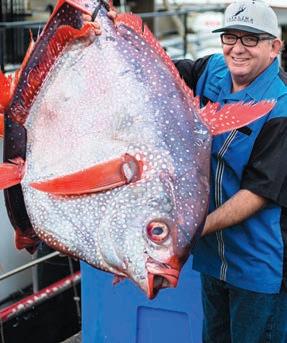
Imagine 25 acres of native edible plants growing 30 feet high. Each foot can produce about four to six pounds of nutrient-dense, umami-flavored produce. The farm requires no inputs—no watering, no fertilizers, no herbicides, not even compost. It attracts wildlife, enriches the ecosystem, and may even help combat climate change.
This is the vision of Sunken Seaweed cofounders Leslie Booher and Torre Polizzi. Their farm would be located some where offshore of San Diego and would grow a variety of native seaweeds, from ogo to kelp to sea lettuce.

“We’d like to disrupt the seafood plate in San Diego and push lower-food-chain items to the center of it,” explains Booher, chief of laboratory operations.
The duo formed Sunken Seaweed in 2017 when they needed
to apply for an incubator with the Port of San Diego, who was looking for small start-up companies in the “blue economy.”
After a year of market research—essentially getting seaweed from a colleague up north and selling it to local chefs at a loss—the Port of San Diego granted Sunken Seaweed the opportunity to do R&D for their nascent underwater business off the G Street Pier in Downtown San Diego.
Sunken Seaweed harvests kelp sporophylls (reproductive tissues) from off Point Loma and brings them to their SDSU laboratory, where they trigger them to release spores. After four to six weeks, they bring twine the spores have settled on to their pilot farm, a humble quarter-acre patch off the unused G Street Pier.
What’s your motivation in your work?
Acknowledging how far we have come, and manifesting what the future will look like.
How is Da-Le Ranch unique in the San Diego County region?
San Diego has been at the forefront of the farm-totable, Slow Food movement, and our team shares an appreciation for food, culture, and community: creating relationships, connecting the bridge between customer and farmer, and giving people access to local, farm-direct quality products. Our clientele are our extended family, not just customers.
What’s your favorite part of life on the ranch?
As an adolescent, I resented everything about ranching: the physical labor, responsibility, dedication, seclusion, work hours, sociallife sacrifices, etc. Ironically, those aspects of the job are what I value most in my work now (minus the commitment, I am still a millennial after all).
What should we know about wholesome meat in today’s world?
This was a really hard question for me. Some people my age get caught up in the dichotomous debate surrounding ethical and healthful eating—from die-hard raw carnivorism to rapidly trending veganism. I feel somewhere in the middle.
I believe in considering and acknowledging the value of what you consume and in eating with thoughtfulness. What went into that item you’re purchasing? There’s more to it than cost. What about heart and soul? Was it cared for? Were the people involved in the process cared for? I also think about the impact of our food choices.
Was it sustainable, ethical, local? Sure, “organic” and “certified inspectors” sound good, but we have to look beyond the labels.
The universe’s currents have taken me full circle; I started out as a city girl, moved to the country as an adolescent, then moved back to the city as soon as I became a legal adult. Now I am content with getting back to the rural life. There will be a point in time where I will have to make an ultimate decision (sacrifice) to either be in the city for the business side of operations or to tend the farm and manage the ranch as a whole—or change paths entirely.
There was a time when I didn’t want anything to do with farming, but once I was on the foodie side of things, I knew this is where I belong. My ambition would be to bring three of my favorite things together into one: food, community, and nature. No matter what ends up happening, my passion for quality food will never subside.
What’s the toughest part about what you do, how do you deliver, and why is that important?
The toughest part of my job is forever evolving for me. Currently, it’s taking work with me —everywhere—even if it’s just in my head. There is no “turning off” what I am responsible for. There might be days where I’m not supposed to have anything planned, but I feel I must always be ready for the unexpected. It can feel easier in the moment to just do everything myself, but I’m learning that there is equal strength and leadership in entrusting my team, delegating responsibilities, and working together.
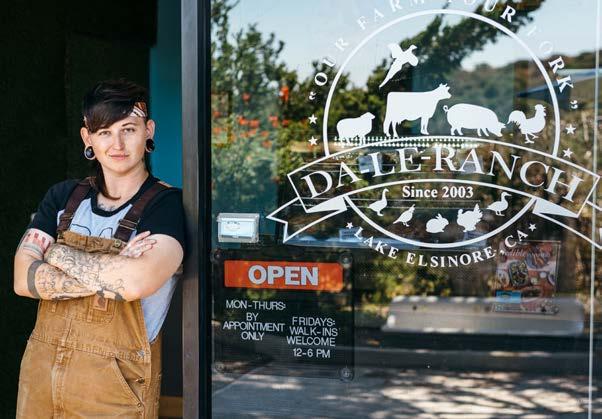
Family owned and operated, our small but mighty ranch (65 acres) puts into practice sustainable farming and natural concepts every day. We make our wholesome, lovingly raised meat products available at farmers’ markets all over Southern California and at a retail facility in Sorrento Valley.

The first months were hard. “It’s definitely been a lot of failing forward,” says Booher, “and we’ve adjusted protocols accord ingly.” They had to learn when to bring young seaweed from their lab to their G Street garden, which they discovered is when they’re big enough not to be fouled over by competitors, but be fore the holds (the root-like part of the kelp) lose strength. They also learned not to outplant when the water is 80 degrees, which, they discovered, is too warm for the juvenile crops. They lost crops in the lab and in the field during this learning phase and continue to develop their protocols for abundant seaweed yields.
“We try to use as much of the water column as we can,” explains Polizzi, chief of field operations. “We grow ogo and other smaller species at about five feet below the surface, and Laminaria and Macrocystis [kelps] at about 20 feet below the surface.” Eventually they’d like to grow shellfish—mussels, scallops, oysters—in hanging baskets, socks, and lanterns intermixed with the seaweed lines.
“I like growing food, creating substance for people out of nothing. It’s just saltwater and sunlight,” says Polizzi. Another product they have in mind is oarweed, the native version of kombu, which is used for a broth base and “when cooked with beans, softens them right up,” says Booher. Elk kelp, whose stalks can be turned into kelp pickles, and other varieties are also on the list.
Besides kelp, oarweed, sea lettuce, and ogo, they’re excited to grow sea truffle, a red seaweed with a nuanced flavor. “You bite

into it and the back of your mouth will just swell, and it will be like that truffle-y taste and you breathe out that really truffle-y smell. And then the tip of your tongue is like black pepper,” waxes Polizzi.
Booher and Polizzi use the pilot garden for fleshing out their laboratory and outplanting methods. With all the bilge in the bay, the products they grow there aren’t suitable for consump tion. Their ultimate goal is to establish that 25- to 30-acre openocean site outside the bay.
The permitting process for open-ocean farming is long and complicated. “We estimate that an offshore scale-up of our project would take around three to five years, and that’s with a full team at the Port of San Diego helping us,” says Polizzi. While
seaweed farming may have a neutral or positive environmental impact, they think it’s a good thing that it takes time. “It’s a new farming method in California and involves growing a domesticated species in a wild habitat. You can’t just put a border around a site in the ocean and expect things to stay in or out of it. And our coastal ecosystems are very fragile, so it’s paramount that the regulations for this practice are done right the first time.”
In the meantime, Sunken Seaweed was awarded a grant to grow seaweed in tanks, and they expect to have product on the market by fall of this year. Booher and Polizzi are confident that creative and community-minded chefs can create even more tempting seafood plates with another level of regenerative local produce grown in San Diego. s
“I like growing food, creating substance for people out of nothing.”
French refer to their wine as having terroir, a sense of place. In San Diego, chefs are creating dishes with that mirror the sentiment, encompassing the land, air, sea, climate, and culture of the county. Conscientious farming practices, mindful harvesting, neighborhood markets, and the boundless creativity of local chefs culminate in delicious dishes that flaunt San Diego’s flavors.
With 36 neighborhood farmers’ markets every week, San Diego offers chefs the chance to step out of their kitchens and into the open air to meander through stalls of fruit, vegetables, eggs, and honey to handpick some of our county’s most perfect produce at peak ripeness. Most chefs don’t arrive with a shopping list; instead, they look to be inspired by the bounty at the market.

TheSome of the specials these chefs create are once-in-a-lifetime dishes or dining experiences, impacted by the time of year, creative influences, and microcrops that are grown on California farms. The dishes offer a bite of a moment in time, encapsulating all the comforts of a memorable meal.
Wheeling a dolly of farmers’ market finds the two blocks from the North Park Farmers’ Market to Tribute Pizza, often through a dining room full of guests, is chef Matthew Lyons’s favorite mo ment of the week. “The beauty of shopping at the market is get ting to try before you buy and letting the produce inspire what goes on the plate. Our philosophy at Tribute Pizza is to buy the
best stuff we can from people we know, season it, apply woodfired heat, and then plate. There’s not a whole lot of technique needed when the produce is already so amazing.”
For a recent Thursday farmers’ market special, Lyons created a wood-roasted caprese inspired by the heirloom cherry toma toes from Valdivia Farms. “We give them a little rinse, but we don’t even remove the stems. The stems carry a bunch of oils and smells that are essential to how fresh these tomatoes are, indicating that they came off a plant only a few hours prior. We have a beast of a wood-fired oven that imparts a beautiful color, roastiness, and tinge of smokiness that concentrates the flavors.” He combined these tomatoes with pesto, burrata, and 18-year aged balsamic for a straightforward yet complex caprese, which is
served with toasted bread.
Every Friday, executive chef Kerry Larceval goes to the La Mesa Village Farmers’ Market, located just steps away from the front door of Fourpenny House. Her first stop is Fred’s Urban Farm to select microgreens like pea tendrils and baby radish. Larceval always picks up their popular Biggie Mix (a seasonal blend that can include sunflower, pea, radish, broccoli, kale, and marigold petals) for a salad dressed with a simple housemade apple cider vinaigrette to accompany one of their best-selling dishes, Crofters pie.
Microgreens might seem a light accompaniment to the stout
Feeling inspired? Head to your neighborhood farmers’ market and whip up a special of your own featuring seasonal produce from local farms.
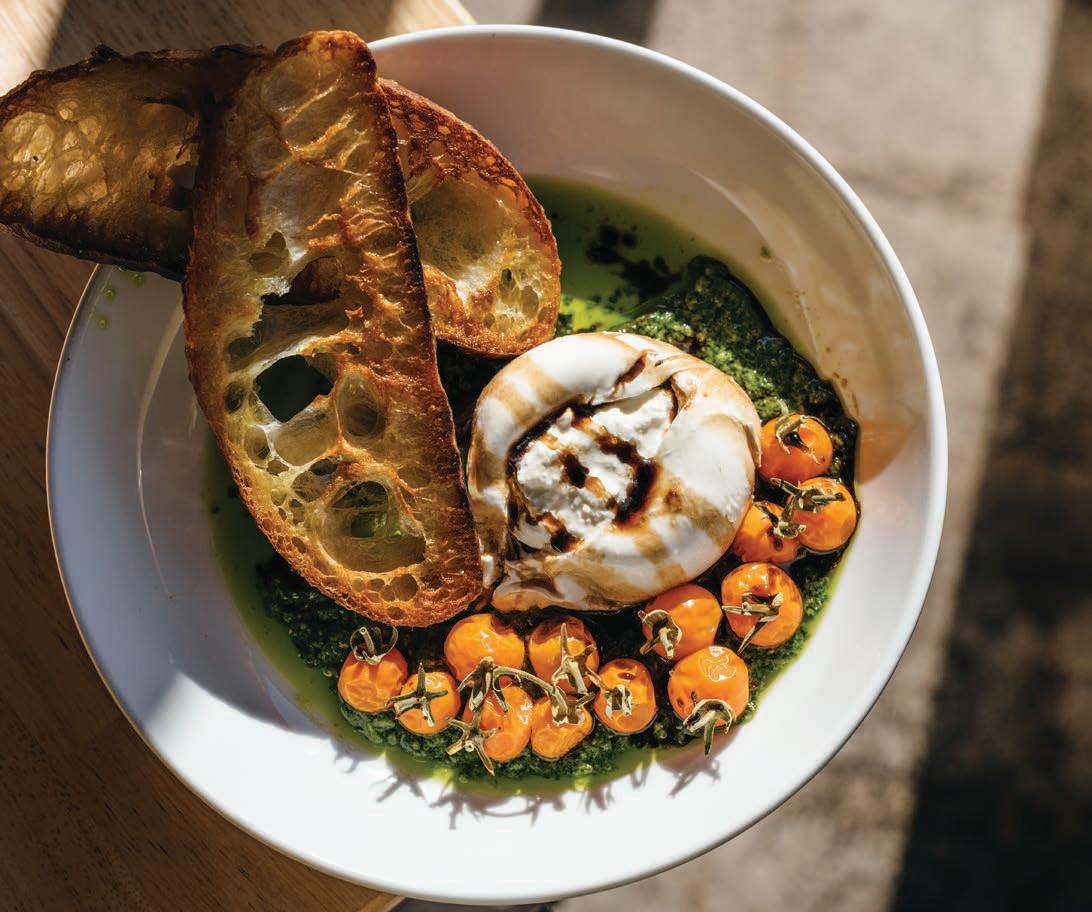
stew of beef, lamb, and roasted veg gies, topped with neeps (rutabaga) and tatties (potatoes), but the microgreens are packed with concentrated nutrients. The sprouts are grown in coconut coir (coconut husk fibers) with just water and offer 40 times the nutritional value com pared to the adult vegetable counterpart. Farmer Robin Kanzius shares, “There are so many benefits to urban farming. We have met countless neighbors we probably would never have had the opportunity to meet. Now, not only do we eat healthier from our own microgreens but we also have a higher standard for purchasing fresh fruits, veggies, and meats from local farmers.”
SDFD Station 40 covers a big region, with access to shop at grocery stores like Trader Joe’s, Sprouts, Costco, and Stater Brothers, and the Rancho Peñasquitos YMCA farmers’ market on Saturdays. Other firehouses are not as fortunate.

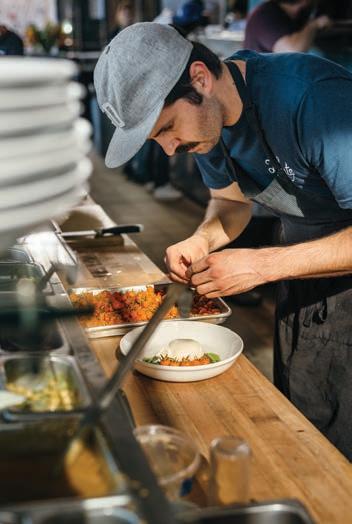


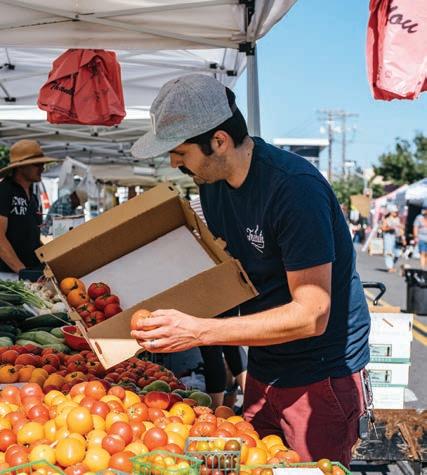
North Park’s Thursday Farmers’ Market isn’t the closest market to BIGA, but chef Tae Dickey goes the extra distance to shop there because that’s where he has the closest relationships with local farms. One of those relationships is with Three Sons Farm, where he buys the chicken that is the feature of BIGA’s chicken four ways entrée. Dickey explains, “I had been looking for hyperlocal poultry and after speaking to Nicholas Jaquez of Three Sons Farm, I asked him if he would raise some chickens for my restaurant. We make a stuffed roulade from the thigh, roast the chicken breast, batter the chicken oysters, and add crispy chicken skin. The jus from the stock made from the chickens is utilized for the sauce.”
Jaquez, the farm manager at Three Sons Farm, shares what makes these birds so special: “We raise chickens for meat and eggs using regenerative farming tech niques. Every year our pastures improve, which helps the environment by seques tering carbon, increasing water reten tion, and cultivating a healthy living soil. When our soil is healthy, our pasture is healthy—and that helps us grow healthy, delicious meat and eggs.”
Chef Cesar Oceguera, a native of San Diego, shops weekly at the Little Italy Mercato for Carté Hotel’s sea-to-table restaurant Watercolors. When he’s looking for fresh ideas, though, he ventures to the Leucadia Farmers’ Market. It was there that he discovered Cyclops Farm and, inspired by the variety of produce, created an edible garden with fresh local veggies “planted” in edible soil. The vegetables for the crudité are treated very simply to allow their natural freshness to shine through. The edible soil, on the other hand, is quite an undertaking. Oceguera explains, “First I toast sweet oat and pumpernickel breads along with some candied walnuts. I add raisins and a little bit of agave for sweetness. Next I butter and season brioche to make my croutons. When they are crispy, I put them in the Robot-Coupe and make them into a sand-like consistency; I take half of that and mix it with a little matcha powder to give the illusion of moss.”
Luke Girling of Cyclops Farm describes their growing prac tices as old-school: “We are certified organic and we use San Pasqual Valley Soils compost to amend our soil and till most leftovers back in. We grow a long list of things from basics like strawberries, carrots, and mixed greens to oddities like purple cauliflower, yellow watermelons, and red long beans.”


Chef Darrell Campbell goes to the Carlsbad Farmers’ Market every Wednesday to get inspiration for specials and new dishes at CLARA. “I’ve been sourcing from the market for my menus for a few years now. I truly enjoy being able to buy local, fresh, organic produce and being able to nourish my guests and myself. It’s supporting a very tough industry—farming is not an easy business. The best way I can support them is to hit up the farmers’ market, which is one block away from CLARA. Some trips to the market I spend wandering around to spark creativ ity and see what farms are offering. You might forget about some veggies if you haven’t seen them in a while.”
These no-longer-forgotten veggies make an appearance in Campbell’s farmers’ market frittata, which often features JR Organics seasonal produce. JR Organics, CCOF certified in 1986, is a year-round seasonal farm growing on 80 acres. With vegetables this good, the preparation is easy. Campbell shares, “The produce I use is simply roasted in the pan, and the eggs are added to make a frittata. I then add some goat cheese for a perfect amount of creamy goodness. This week, I used zucchini, Gold Bar squash, and broccoli from JR. I then topped it with avocado and cherry tomatoes, also from JR. I enjoy nourishing people with healthy, organic ingredients.” s
Tanner Saraspe doesn’t dine out much.
Late nights don’t mix well with a fisher’s early morning schedule, but when she does, it’s often at Juniper & Ivy.
Her choice of eatery is no coincidence. Saraspe is part of the third-generation fishing family that supplies the Michelin Bib Gourmand restaurant with local seafood like spiny lobster, halibut, bluefin tuna, and California spot prawns.

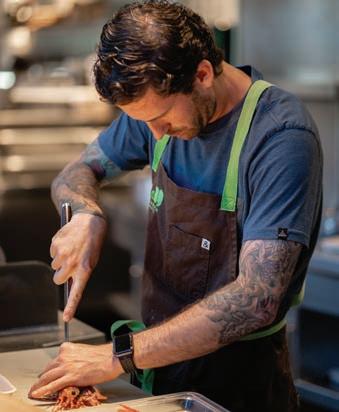

But it’s not just the professional connection that gets her in the door. It’s the relationship she’s cultivated over the years with executive chef Anthony Wells.
“She’s very genuine,” says Wells about Saraspe. “She’s easy to talk to, easy to work with, and she’s very honest…every time [she] swings in, we usually sit outside and chat for 20 or 30 minutes and talk about food and fishing.”
Saraspe recalls one of her more meaningful visits to Juniper & Ivy: “For my grandma’s 82nd birthday, we brought her there with the whole extended family, and they just took care of us. Anthony came out and said hello to everyone. It was such a special experience.”

For Saraspe and Wells, a normal day means they might not even run into each other. They’ve worked together for so long that Saraspe simply texts Wells with the day’s catch and lets herself into the kitchen with his order, wrapping up the fresh product in containers and organizing them in the walk-in.
She laughs at the casualness of it. “The days he is there, he always goes out of his way to say hi and talk to us for a little bit.
It just brightens my day when you get moments like that.”
That trust, carefully cultivated over the years, is uncommon in the hospitality industry, but Saraspe and Wells recognize the significance of mutually promoting sustainable seafood. The National Marine Fisheries Service estimates that the United States imports more than 80% of the nation’s seafood, often from countries that have little to no oversight over the industry. But as of this May, 100% of Saraspe Seafoods’ catch stays in San Diego. This includes the prized spot prawns. Fewer than 20 permits in all of California were issued for spot prawn fishing, and Saraspe’s father holds one of them.
His harvesting technique for all species minimizes bycatch—an important aspect in promoting safe and sustainable fishing and one that Wells emphasizes as part of the Juniper & Ivy message.
“For us, local is the right thing to do,” says Wells. Saraspe agrees, although she admits that it would be easier (and more profitable) for her family to fish outside of American waters. But with customers like Wells, who value long-term ecological accountability, it’s worth it.
“We’re able to tell a story,” explains Saraspe. “It’s special.”
Wells hopes to one day take his crew out on a fishing excursion with Saraspe to give them a firsthand look at where their seafood comes from. She says she’s ready anytime. Perhaps the next Juniper & Ivy special will be a chef-caught, true tide-totable dish. s












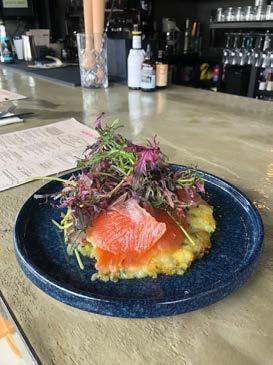
















Habanero jamz, a great spicy & avorful twist to traditional preserves. Perfectly balanced between sweet & spicy. Find us online and at your local farmers market

San Diegans have long enjoyed close proximity and easy access to Tijuana for tacos, beer, and inexpensive shopping. But with more and more Baja restaurants, boutiques, brewer ies, and cultural opportunities launching by the day, trips to our sister city have created a bounty of new lodging options that fit any budget and lifestyle.
One of the most exciting new hotels is One Bunk in the heart of Zona Centro, Tijuana’s bustling downtown district. Historically, and to a lesser extent today, downtown Tijuana has been considered a tourist trap. But the past few years have brought massive changes to the main drag through the area Avenida Revolución.
One Bunk opened in May 2017 with nine rooms, which has since expanded to 14. The building originally housed the 1950sera Hotel Lafayette and still boasts the name in bold neon letters facing Ave. Revolución. The dual name can cause confusion to those unfamiliar with the property, so Tania Lopez, concierge at One Bunk, explains it: “[I]n honor of the building’s history, they [the architects and owners] decided to place the Hotel Lafayette
neon sign outside instead of the One Bunk name. So we are One Bunk TJ located in the historic Lafayette building.”
Arriving at One Bunk is fairly straightforward, even for visitors who don’t speak Spanish. Those who walk from the San Ysidro border crossing should be sure to use the new PedWest pedestrian crossing in lieu of the older bridge near the trolley. (Confession: I made that mistake this trip and will not be making it again.)
Shuttles are available and affordable (as in, $1) from the San Ysidro trolley stop to the PedWest corridor by the Las Americas outlet mall. From there, stroll across the border and either rideshare or take the short walk to Ave. Revolución.
Those who prefer to drive have the benefit of free parking in the adjacent Soriana Market parking lot on Ave. Revolución between 2nd and 3rd. Validation is available inside One Bunk, so don’t forget to grab your ticket.
One Bunk is located in the heart of downtown between 3rd and 4th, practically in the shadow of the iconic Tijuana Arch. Unless you’re very comfortable driving in near-constant traffic or are familiar with the area, it’s easiest (and frankly more fun) to explore the neighborhood on foot.
Upon arrival, journey up the stairs to the One Bunk lobby. (You’ll pass a small window slinging tacos to go, and no one would blame you if you snagged a few on the way.) Tropical trees and broad-leaf palms command the astutely hipster space,

complete with scrawly neon signs, a record player, and plenty of curated mid-century modern furnishings.

Once the onsite host checks you in, enjoy the second lounge area featuring a foosball table and a Polaroid wall. Make sure to check out the cascading light fixture made completely of tennis rackets.
Architect Jorge Gracia from Gracia Studio worked with local artist Seth Sullivan and Bien designer Gibran Huerta to develop the concept and furnish the space. Huerta’s design studio came up with the logo and branding, which inhabits every inch of the area from custom water bottles to guest notepads in each room.
become accustomed to, like riffs on pizza and Asian-inspired pork belly with a Tijuana twist. The tostada de pulpo (octopus tostada) was wonder ful to share, but I mostly hoarded the slow-braised tacos de lengua (tongue tacos) topped with charred pineapple, and guacamole and served on fresh corn tortillas for myself.
American visitors will be pleased with the cost of things in Tijuana as well. At La Justina, our party shared four cocktails, two appetizers, two entrees, and a dessert with the final bill coming out to around $75 USD. The vast majority of places take US dollars but small bills are preferable to avoid making change.
Get handcrafted Mexican leather goods straight from the designers at this small showroom within One Bunk. Paseo de los Héroes 9415

» milesandlouie.com
The award-winning eatery slings craft cocktails and elevated fare without a heavy price tag. Located just below One Bunk, it’s a great spot to relax in the heart of Tijuana. Avenida Revolución 990
» facebook.com/lajustinatj
The historic restaurant is known around the world as the birthplace of the Caesar salad. Expect old-school service and French-meets-Mexican cuisine. Avenida Revolución 1079
» grupoplascencia.com/caesars

For as much art as One Bunk has to offer, there’s plenty more to see, eat, and drink right outside its doors. Trendy La Justina occupies the ground floor of the building, and the iconic Caesar’s—the birthplace of the Caesar salad—is across the street.
La Justina’s menu unites swanky gastropub fare many Americans have
Plenty of craft breweries line the streets of Zona Centro. Border Psycho, Mamut, and Cervecería Transpeninsular are all within easy walking distance, as is Estación Central (where I heartily recommend the Chinese fried rice and cocktails). Other renowned watering holes such as Public House, Insurgente, and 52 Kool are quick car rides away. s
The Revolución outpost of popular Tijuana brewery Border Psycho provides a calmer beer experience in downtown.
Unlike many nearby bars, Border Psycho is relatively laid-back, with a diverse array of styles to choose from. Calle Libertad 1751
» borderpsychobrewery.com
Read the story on ediblesandiego.com for more of Beth’s Tijuana hot spots.

Plastic pollution is suffocating our oceans at a scale so vast that it is hard to grasp. There are now over 5.25 trillion pieces of plastic in the world’s oceans and it’s threatening marine animals in all parts of the global ocean ecosystem.
It’s a daily problem in San Diego County. According to data collected by our volunteers, 80% of the trash collected at beach cleanups consists of singleuse plastic, much of it originating from restaurants. We collect over 20,000 pieces of styrofoam each year, the majority coming from takeout containers. So what’s the best way to combat this global epidemic facing our ocean?
In 2015, Surfrider Foundation San Diego County activists launched the Ocean Friendly Restaurant (OFR) program, and now the program is national. Currently, there are 523 OFRs nationwide and 110 of those are in San Diego County.





Participating restaurants must institute specific mandatory practices that reduce plastic waste, and if they adhere to all of them, they are registered as a Platinum Level OFR.
On our end, Surfrider Foundation San Diego County recognizes participating OFRs to more than 45,000 San Diego County consumers and over a million Surfrider supporters through various media, monthly newsletters, the OFR Mobile App, emails, and community events. Surfider also provides OFRs with window stickers, table-toppers, diner brochures, bill stuffers, posters, alternative product information, and vendor discounts.
When dining out, request a reusable mug. Taking home leftovers? Bring your own reusable container. When taking out, use your own bag. Decline plastic flatware and use your own.
Keep a reusable water bottle and shopping bags with you. Take the “Plastic Straws Suck” pledge.
Show your support by frequenting registered OFRs and let them know that you appreciate their commitment to the environment.
Find a full list of local OFRs in San Diego at surfridersd.org/ofr.
If your favorite restaurants are not already OFR registered yet, be sure to tell them about the OFR program and send them our way.
The Surfrider Foundation is a nonprofit grassroots organization dedicated to the protection and enjoyment of our world’s oceans, waves, and beaches through a powerful activist network. San Diego County boasts the largest and most active of Surfrider’s 80+ chapters and is responsible for protecting San Diego’s 72 miles of coastline.
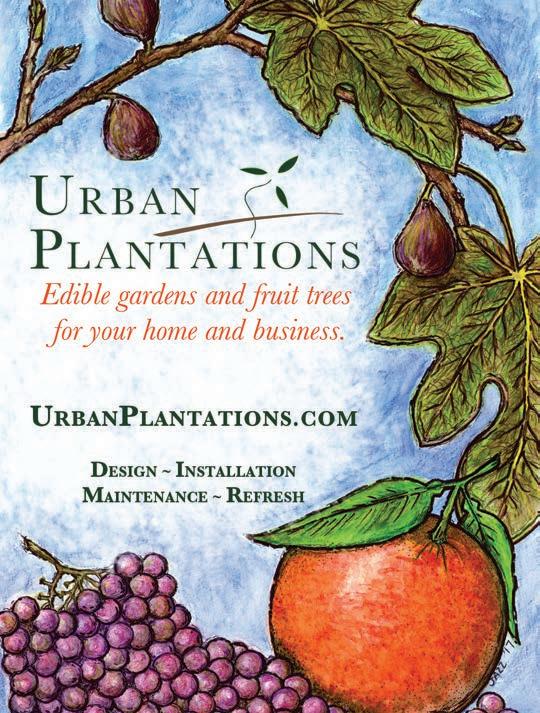















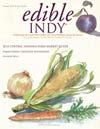










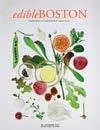

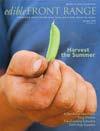







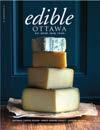











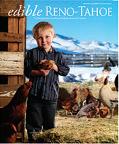










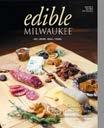





















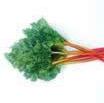


















Over two dozen restaurants in Del Mar Village serve up tasty bites for the popular Taste of Del Mar event on September 5.
» visitdelmarvillage.com
Support Ecolife’s sustainable agriculture and community-based conservation programs at a theater-themed fundraising gala at the California Center for the Arts on September 7.
» ecolifeconservation.com
Farm to Fork Week takes place September 9–15, with prix fixe menus and specials at participating restaurants celebrating local produce,
seafood, beverages, and meats.
» farmtoforksd.com
Join Edible San Diego’s associate and visuals editor Olivia Hayo for a one-of-a-kind garden and food photography class at Dickinson Farm on September 14.
» wddickinson.com
San Diego Restaurant Week returns September 22–29 with steep discounts on lunch and dinner at over 180 restaurants throughout the county.
» sandiegorestaurantweek. com
More than 200 local and regional makers will
showcase their creations in Balboa Park at the fifth annual Maker Faire San Diego October 5–6.
» sandiego.makerfaire.com
Chef Christina Ng will cook up an Indian summerthemed dinner with seasonal produce plucked from the fields at Dickinson Farms on October 12.
» wddickinson.com
Marvel at jumbo gourds during Julian Beer Company’s giant pumpkin contest on October 26.
Winners will be crowned in several categories, including biggest, prettiest, and most unique.
» julianbeercompany.com
Find more events online at ediblesandiego.com/event-list.
BY MARIA HESSEThey may have become a bit generic and overrated in a spiced latte, but let’s face it—pumpkins always end up being one of our favorite crops of the season. Touted as a superfood, pumpkins are low in fat and calories but rich in vitamins A, B, and C, iron, zinc, potassium, and beta carotene, and high in fiber. The seeds, often referred to as pepitas and prominent in Latin cuisines, have been linked to promoting hair growth and lowering blood sugar levels, making them perfect for a snack or crunchy garnish on a salad.

There are 45 varieties of pumpkin and all of them are edible. Personal favorites include heirloom varieties like the buff-colored Long Island Cheese that bakes an exceptional pie, or the white Polar Bear pumpkin that makes a silky soup. Pumpkin flesh is versatile to use in a range of dishes beyond baking. Try them as the feature ingredient in a Thaistyle curry or roast and mash them with rosemary, butter, and cream for a delicious side dish.
For a great local U-pick pumpkin event, check out Bates Nut Farm in Valley Center, complete with food truck pop-ups and pony rides running September 21 through October 31.
» batesnutfarm.biz
BY DEBRA BASSThe enchanting New England-style cottage at the end of a landscaped brick walkway would be welcoming if it wasn’t hanging precipitously off the side of a six-story building.
Artist Do Ho Suh’s “Fallen Star” explores the sensation of being displaced—or better said, untethered. He visualized the cultural vertigo of his relocation to Providence, Rhode Island, from his native home in Seoul, Korea, by constructing a fully furnished familial bungalow that physically captures the queasy sensation of an awkward cultural disconnect better than any artist statement ever could.

As part of UC San Diego’s Stuart Collection, the structure can be viewed from a number of vantage points around campus, but it’s best experienced by venturing inside. Upon entering the house, guests are immediately thrown off balance due to the fact that the floor, ceiling, and walls are all designed without traditional right angles. Most visitors report the overwhelming sensation of falling.
Fallen Star is open and free to explore at Jacobs Hall on Tuesdays and Thursdays from 11am to 2pm.
These restaurants are either locally owned, passionate about local sourcing, or both. Enjoy a delicious meal and make sure to tell them that Edible San Diego sent you! Edible San Diego celebrates Surfrider Foundation’s San Diego County Ocean Friendly Restaurant (OFR) program, which incentivizes and recognizes eateries across the country that uphold specific environmentally-friendly practices. Together we can take everyday steps to improve the health and vitality of our world’s oceans. Restaurants in this Guide who have stepped up to become OFR certified are noted.

ESCOGELATO

122 South Kalmia St., Escondido 760-745-6500 • escogelato.com
Located in the heart of Escondido, EscoGelato is made fresh daily using the highest quality ingredients and fresh fruit sourced from local farmers. The result is a luscious, super-creamy gelato that’s full of flavor. You will taste the difference. In addition to the main event, enjoy a nice selection of paninis, soups, salads, coffee, and tea.
SOULSHINE VEGAN CAFE

3864 Mission Blvd., San Diego 858-886-7252 • soulshinemb.com
If you’re looking for fresh, clean, and quality vegan food, then head to Soulshine. They offer vegan and vegetarian foods that are thoughtfully sourced from local farms. At Soulshine in Mission Beach you can get acai bowls, delicious coffee, a vegan beach burger or mac and cheese; plus, you can pop in for an amazing brunch! Visit Soulshine and work toward a healthier you, a healthier community, and a healthier earth. OFR
SOLARE
2820 Roosevelt Rd., San Diego 619-270-9670 • solarelounge.com
Solare is an authentic Italian restaurant with a special focus on southern Italy and Sicily featuring a menu made with fresh ingredients selected daily. Blending modern and traditional tastes, the results are light and healthy dishes brimming with natural flavors. Complement your meal with one of 2,000 bottles of wine from the cellar or 30 wines by the glass. Solare is committed to serving the cuisine of today, created with all the love and attention to detail from generations past.

MITCH’S SEAFOOD
1403 Scott St., San Diego 619-222-8787 • mitchsseafood.com
Established in 2008 by three families with a long history of fishing in the Point Loma area of San Diego, Mitch’s Seafood specializes in fresh seafood from the waters off San Diego. Located on San Diego’s working waterfront with a view of the fishing fleet, the menu focuses on simply prepared, California-style seafood and selection of craft beer and wine sourced from local San Diego and California purveyors.

THE WILD THYME TABLE
555 W. C St., San Diego 619-269-7091 • thewildthymetable.com
A cafeteria-like deli born from a local catering company, the Wild Thyme Table specializes in sandwiches, salads, and fresh pastries and focuses on healthy fare made from scratch, with an emphasis on flavor. The restaurant has been designed to offer a bright, light interior that complements the fresh menu offerings with an inviting outdoor patio. Menu highlights include the citrus turkey sandwich, the Cobb-notCobb salad with blackened sweet potatoes. Don’t miss the banh mi bao, a twist on one of the most craveable sandwiches on earth.

GARDEN KITCHEN
4204 Rolando Blvd., San Diego 619-431-5755 • gardenkitchensd.com
Located in the San Diego neighborhood of Rolando, this healthy farm-to-table restaurant satisfies all tastes, from vegan to vegetarian to meat lovers. All meals are served outside on a lovely covered patio with a casual, dog-friendly atmosphere. Their menu changes regularly because each day it’s crafted from scratch using local, farm-fresh ingredients. Their cooking style reflects a love of all flavors, colors, cuisines, and cultures.
Escondido—Welk Resort √†
8860 Lawrence Welk Dr. 3–7pm, year-round 760-651-3630
Coronado √
1st St. & B Ave., Ferry Landing 2:30–6pm 760-741-3763
Escondido √* 262 East Grand Ave. 2:30–7pm (2:30–6pm Oct to May) 760-480-4101
Mira Mesa √* 10510 Reagan Rd.
2:30–7pm (3–6pm fall-winter) 858-272-7054
Otay Ranch—Chula Vista 2015 Birch Rd. and Eastlake Blvd. 4–8pm 619-279-0032
Pacific Beach Tuesday √ Bayard & Garnet 2–7pm 619-233-3901
People’s Produce Night Market 5010 Market St. 5–8pm 619-813-9148

San Marcos NEW! √ 1035 La Bonita Dr. 3–7pm 858-272-7054
UCSD Town Square √ UCSD Campus, Town Square 10am–2pm, Sept to June 858-534-4248
Santee *†
Carlton Hills Blvd. & Mast Blvd. 3–7pm (2:30–6:30pm winter) 619-449-8427
State Street in Carlsbad Village √ State St. & Carlsbad Village Dr. 3–7pm (3–6pm fall-winter) 858-272-7054
Temecula—Promenade √*
40820 Winchester Rd. by Macy’s 9am–1pm 760-728-7343
Lemon Grove √* 2885 Lemon Grove Ave. 3–7pm 619-813-9148
Linda Vista √*† 6939 Linda Vista Rd. 3–7pm (2–6pm winter) 760-504-4363
Bernardo Winery √
13330 Paseo del Verano Norte 9am–1pm 760-500-1709
City Heights √*†!
Wightman St. btwn Fairmount & 43rd St. 9am–1pm 760-504-4363
Del Mar √ 1050 Camino Del Mar 1–4pm 858-465-0013
Little Italy Mercato √† 600 W. Date St. 8am–2pm 619-233-3901
Pacific Beach √ 4150 Mission Blvd. 8am–noon 760-741-3763
Murrieta √*
Village Walk Plaza
I-15, exit west on Calif. Oaks & Kalmia 9am–1pm 760-728-7343
North San Diego / Sikes Adobe √† 12655 Sunset Dr., Escondido 10:30am–3:30pm 858-735-5311
Rancho Santa Fe Del Rayo Village √ 16077 San Dieguito Rd. 9:30am–2pm 619-743-4263
Santa Ysabel √ 21887 Washington St. Noon–4pm 760-782-9202
Solana Beach √ 410 South Cedros Ave. Noon–4pm 858-755-0444
501 W. Date St.
9am–1pm 619-233-3901
Ocean Beach √ 4900 block of Newport Ave. 4–8pm 619-279-0032
North Park Thursday √*† 2900 North Park Way 3–7:30pm 619-550-7180
Oceanside Morning √* Pier View Way & Coast Hwy. 101 9am–1pm 760-791-3241
Rancho Bernardo 16535 Via Esprillo 11am–1:30pm 619-279-0032
Borrego Springs √ 700 Palm Canyon Dr. 7am–noon, Oct to Apr 760-767-5555
Horton Plaza Lunch Market 225 Broadway Circle 11am–2pm 619-795-3363
Imperial Beach √*† 10 Evergreen Ave. 2–7pm, (2–6pm winter) info@imperialbeachfarmersmarket.org
La Mesa Village √*
La Mesa Blvd. btwn Palm & 4th St. 3–7pm, year-round 619-795-3363
Poway √* 14134 Midland Rd. 8am–1pm 619-249-9395
Rancho Penasquitos 9400 Fairgrove Ln. 9am–1pm 858-484-8788
Temecula—Old Town √* Sixth & Front St., Old Town 8am–12:30pm 760-728-7343
Vista √*† 325 Melrose Dr. 8am–1pm 760-945-7425
Hillcrest √*
3960 Normal & Lincoln Sts. 9am–2pm 619-237-1632
La Jolla Open Aire √ Girard Ave. & Genter 9am–1:00pm 858-454-1699
Leucadia √* 185 Union St. & Vulcan St. 10am–2pm 858-272-7054
* Market vendors accept WIC (Women, Infants, Children) Farmers’ Market checks.
† Market vendors accept EBT (Electronic Benefit Transfer).

! Market vendors accept WIC Fruit and Vegetable checks.

√ Indicates markets certified by the San Diego County Agriculture Commissioner, ensuring that the produce is grown by the seller or another certified farmer in California, and meets all state quality standards. Temecula markets and the Murrieta market are certified by the Riverside County Agricultural Commissioner.
Visit ediblesandiego.com and click on “Resources” for more complete information and links to market websites.






With countless iterations the world over, it seems inconceivable to think that a burger could have a stake in the game of originality. Tom Logsdon, owner of the unassuming Balboa Bar and Grill in Bankers Hill, challenges the notion with the meaty opah burger.

This sustainably harvested fish can be found in various cuts at Catalina Offshore Products. They’ve partnered with NOAA through a grant to support a year-long initiative that educates local chefs, fisheries, and consumers on how to use the whole fish through events like Ocean to Table at Portuguese Hall on September 24. The culinary tasting experience will showcase samples from leading chefs, aspiring to encourage more people to try opah in diverse and enticing dishes.
Thanks to Logsdon, you can make this burger at home. Prepare to feel tricked by the first bite because there really is nothing fishy about it.
» sandiegoopah.eventbrite.com
1 pound ground opah (abductor cut) 2 teaspoons ground black pepper 1 teaspoon salt 1 egg
1 cup mayo ¹/³ cup buttermilk 3 cloves garlic, finely minced ½ teaspoon ground dried chipotle pepper 1 ½ teaspoons ground cumin ½ teaspoon lemon juice 1 teaspoon Worcestershire sauce
4 brioche or Hawaiian burger buns
Lettuce, sliced tomato, thinly sliced red onion, and pickles to serve
Prepare the burgers: Mix all ingredients in a large bowl and form into 4 quarter-pound burgers.
Use a heavy skillet or cast-iron pan over high heat with a touch of olive oil to cook opah patties, about 2 minutes on each side.
Prepare the aioli: Mix all ingredients thoroughly and chill for 15 minutes.
Assemble: Toast buns and spread aioli evenly on the top and bottom halves. Layer with lettuce, tomato, onion, pickles, and the opah patty.










